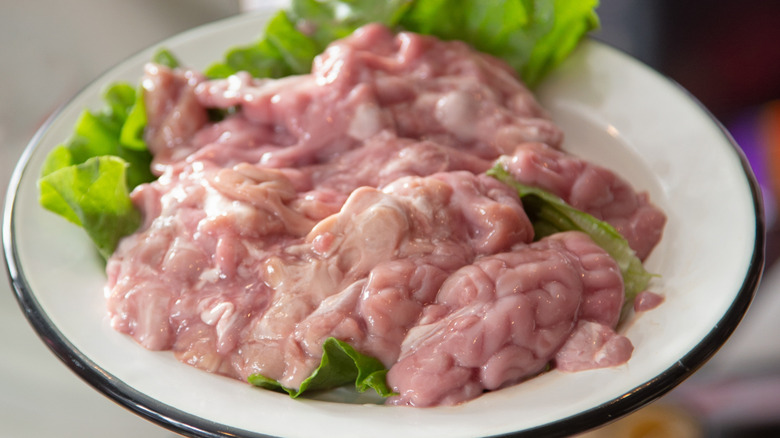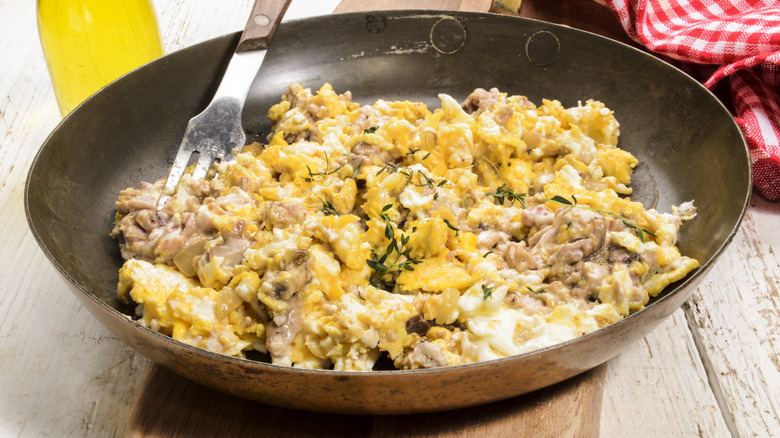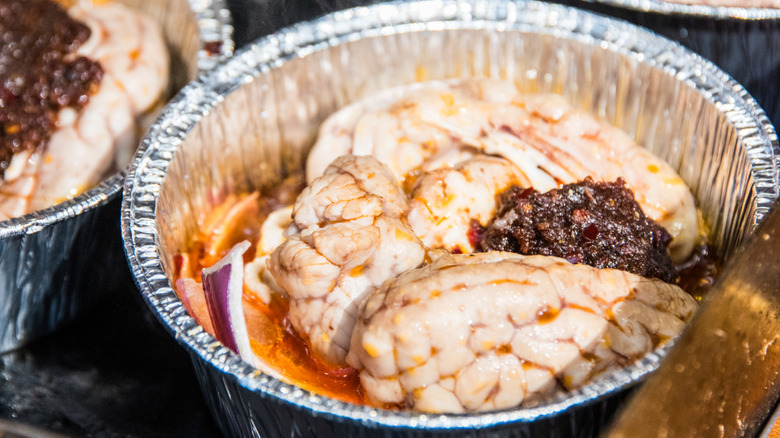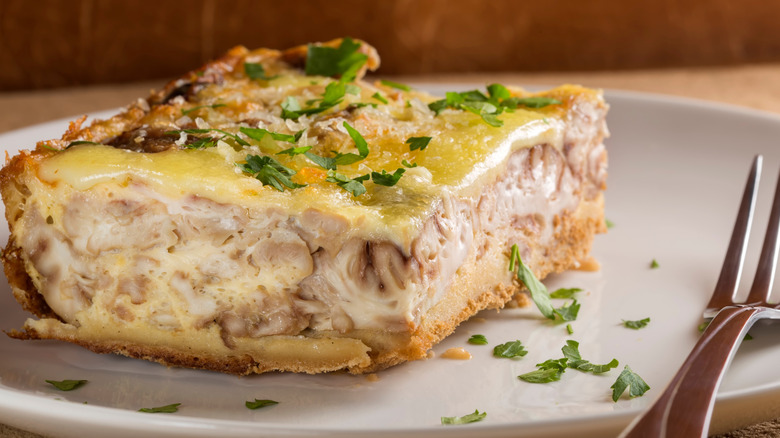What Are Canned Pork Brains & Can You Still Buy Them?
We may receive a commission on purchases made from links.
Canned pork brains might sound like something one would serve to a zombie rather than a foodie, yet this item has long held a place in American cuisine. Although it may sound strange to many, consuming brains as a foodstuff has occurred all over the globe for centuries.
Many cultures once considered brains as a delicacy. The item was highly coveted in ancient societies due to its rich and fine nature, not to mention how difficult it was to remove, being safely packed inside the skull. While this positive sentiment never seemed to take root on U.S. soil, it hasn't been completely abandoned. Today, brains are still consumed in many cultures — take Mexican tacos de sesos for instance, which utilize cow or goat brains, or Sichuan hot pots, which still commonly contain pork brains. Although lesser known, pig brains still hold a firm place in multiple styles of cuisine.
Like many organs, brains have long been considered an underrated cut of meat and are arguably one deserving of more attention. Canned pork brains seem to be an especially neglected offal, with few ever hearing of this variety meat, let alone being tempted to try it. Yet, little known to many, tinned pork brains are a foodstuff with a fascinating heritage — one far more mind-boggling than any other canned meat.
A cherished Southern ingredient
A fully-cooked offal that comes out of the tin ready to heat and serve, canned pork brains gained their fame alongside the formerly beloved breakfast dish brains and eggs. Made by seasoning pork brains with salt, pepper, and paprika, cooking the organ until it browns, and adding in a few beaten eggs, this morning meal was once an extremely popular dish in the South in the mid-1900s, with recipes dating back as early as 1896.
Brains, being especially fatty, provide a richness to this simple breakfast food — and because they're a very similar texture to scrambled eggs, the meat blends in perfectly. Add in a biscuit, and you've got the complete Southern breakfast. Now a dish rarely served, eggs and brains has joined the forgotten ranks of other antiquated brain dishes, like fried brain sandwiches, a Midwestern classic made by breading and frying pork brains, popping them in between a bun, and adding mustard, onions, and pickles.
Eating offals like pig brains was likely a habit established by livestock farmers who ate the offals after butchering their own stock. However, the process for using fresh hog brains is much more time-consuming. Fresh brains must be soaked in milk or water for a few hours in order to draw out the surplus blood. Canned pork brains bypassed the need for this step by packing the foodstuff in milk gravy, streamlining the cooking process for the masses.
A canned good that many find hard to stomach
To say Americans can get a little "in their head" about eating pork brains is an understatement. Today, most consumers turn their nose up at offals like pork brains, thinking them to be unappealing, or at the very worst grotesque. There are likely multiple factors at play here, but for some people the stumbling block is psychological. While items like ground beef and bacon look drastically different from the animals they come from, offals are much more recognizable as body parts, so the process of preparing and consuming them appears more akin to cannibalism than cooking.
Even for those who can get past the shock factor of dining on brains, there's also the look and texture of this ingredient. Some find tinned pig brains to resemble pet food rather than something suitable for humans. The texture is another hurdle for many — many say pork brains mirror curdled yogurt, having a creamy albeit substantial texture.
There's also a historic component in our attitudes towards organ meats. As the industrialization of livestock rendered steaks and other revered cuts of meat more accessible in the late 20th century, these prime cuts became synonymous with success. By contrast, offals became equated with economic hardship, making them a less appealing ingredient. Over time, this divide grew further. Steaks became analogous with the American identity while organ meats came to be associated with the immigrant population, growing ever more distant from what would be considered standard fare for an increasingly homogenized, national cuisine.
Part of a WWII propaganda campaign
While eating animal organs may have been common practice to farmers who butchered their pigs in the fall, this concept was foreign to many urban Americans. Still, efforts have been made to spread this valuable foodstuff to the wider public. During World War II, meat was limited and campaigns were undertaken to motivate individuals who had previously never eaten offals to try this unusual meat, although these efforts ultimately appeared futile.
Red meat became especially sparse during this food-restricted, war-time era. Considered an ideal foodstuff to sustain military men, steaks were sent to army bases rather than store shelves. In the wake of their disappearance, recipe books motivated American women to help out with war efforts by cooking with offals or variety meats like kidneys, tripe, and livers. Brains were recommended to be breaded and fried, made into croquettes, served cream-style on toast, or even used in salads. Instead, most chose to stretch standard meats as far as possible, adding them to casseroles and soups instead of trying these less-established cuts.
The trend of variety meats failed to catch on for the wider public, and once the war ended, the distaste for offals like pork brains became even further entrenched. Once red meat returned to the market, many were eager to enjoy a foodstuff that had previously been inaccessible. Additionally, postwar prosperity made pricier cuts of meat more attainable, leaving offals like pork brains — a cut many now associated with struggle and shortages — securely in the past.
An ingredient that sparked health concerns
Some have shied away from pork brains over the years for health reasons, as this heady foodstuff contains high amounts of cholesterol and sodium. Rose Pork Brains with Milk Gravy sells its product in two sizes. The single serving-sized 5-ounce can contains 1,060% of an individual's daily recommended amount of cholesterol along with 21% of your daily sodium dose. The 7-ounce can has no less. While labeled as holding 3.5 servings of 2 ounces, each serving still contains 375% of one's daily cholesterol.
In the 1950s, the connection between heart disease and cholesterol became more apparent in the science community, and a more health-minded consumer base began to lend a more discerning eye to their plates. By the late 1970s, the U.S. government had formally declared low-fat diets to be healthier, prompting culinary trends to shift. But this hasn't been the only health concern to arise in regards to pork brains.
Worries of prion disease were brought to national attention in the 1990s by mad cow disease, causing fears that similar illnesses might be transmitted via pig brains. Even 30 years later, brains have never fully recovered in the public's eyes. A lesser known case has sparked further worries on the production end. Back in the 2000s, several workers at a Minnesota pork processing plant became ill after inhaling hog brain tissue triggered an immune response. Although this isn't something that can occur from eating pig brains, it certainly hasn't done anything to help pork brains' public image.
An offal that hasn't made the nose-to-tail resurgence
Back in leaner times, cooks once strove to leave nothing to waste when butchering an animal, using all edible parts including the tongues, livers, lungs, kidneys, and the brain. Known as "nose-to-tail-cooking," this attitude has recently received a resurgence as part of the sustainable cooking movement, but pork brains haven't seemed to be included in the revival. The nose-to-tail movement has gained traction for being environmentally friendly, monetarily practical, and contributing to less food waste by utilizing all parts of an animal in lieu of disposing of them.
Why haven't pig brains seemingly made the cut? The choice to exclude this offal might be in part due to its lack of nutritional content in comparison to other variety meats. Most organ meats are abundant in B vitamins, magnesium, and selenium, offsetting the fact that they are also high in saturated fat and cholesterol. Generally, eating the whole animal instead of select parts provides a vaster array of nutrients to the body. When compared head to head, many organ meats actually deliver more nutrients than muscle meats, like steak and chops.
Beef liver is high in vitamin A, iron, and zinc; bone broth is rich in protein and minerals; and beef heart is an excellent supply of CoQ10. The two organ meats that don't seem to have as many nutrients are brain and tripe, with brains having little to boast other than their levels of omega-3 fatty acids. Having less health benefits makes pork brains a harder sell in the nose-to-tail crusade, be they canned pork brains or those fresh from the butcher.
Where you can buy pork brains
Still interested in testing out this lesser known offal? Currently, only one canned pork brain offering still stands: Rose Canned Pork Brains. Kelly's and Armour, two other once-common brands, have since ceased canning this pig offal. Kelly's, whose product once featured a pipe-smoking leprechaun on the label, discontinued pork brains some years ago — reducing its tinned offerings to just chili and beef stew. Armour, a Chicago-based company with roots stretching back to 1867, has shifted their focus to frozen and refrigerated meats, although they do still offer a variety of canned goods, like Vienna sausages and potted meat.
Rose Pork Brains are made in Sanford, North Carolina and distributed by Boone Brands, a company that also cans Brunswick stew and beef tripe. A few grocery stores still stock this sole surviving canned good, as well. In the South, you may still find this regional classic in supermarkets like the Piggly Wiggly and Food Lion. It can also be ordered online through retailers like Amazon and Walmart.
Still, those intrigued by this brainy fare might be interested to know that it can also be bought fresh or frozen. Frozen pork brains can occasionally be found online as well as in store at locations like the Piggly Wiggly. Additionally, it's worth paying a visit to your local butcher shop to see if you might be able to purchase fresh cuts in person. Just remember, you're unlikely to find them at your grocery store's meat counter. Instead, try an international butcher shop or an Asian or Latino market, like a carniceria — as these are both cultures where offals are still commonly eaten.
Pork brains are still around, but recipes aren't
Although you can still buy canned pork brains as of now, the recipes using them seem to be in short supply. When you check the section under pork brains recipes on Boone Brands' product website, the info is blank. Likewise, many recipes using this canned good have vanished from cookbooks over the years, decreasing with each new edition until finally being removed entirely. Take "The Joy of Cooking" for example. While the 1943 edition of this classic cookbook held six recipes for brains, its 1975 edition only held four. By 1997, only one recipe was preserved — one which would not make the cut for the next edition in 2006.
While common dishes like brain-scrambled eggs and fried brain sandwiches are a little easier to find, these are far from the only recipes to use this hog part. With recipes using this foodstuff disappearing, it's becoming harder to recreate more obscure organ dishes, like brain cakes (a crab cake-like concoction). Still, a few recipes can be found online, including that of fried pork brains, pork brain pudding, and Chris Cosentino's brainaise, in which the offal expert makes a creamy condiment of this pig part. One can also search for general brain recipes, such as Cosentino's brainy eggs, which uses calf brains and a duck egg.
Perhaps you even have your own pork brain recipe tucked away in the pages of your family cookbook. If you do, snap a photo and share it. Even if you wouldn't mind tinned pork brains joining the ranks of canned foods we'll never see again, others might disagree. There are still those trying to keep these brain-based dishes alive so other brave and enterprising souls can sample them.








